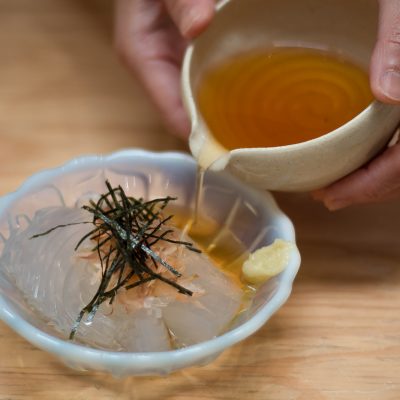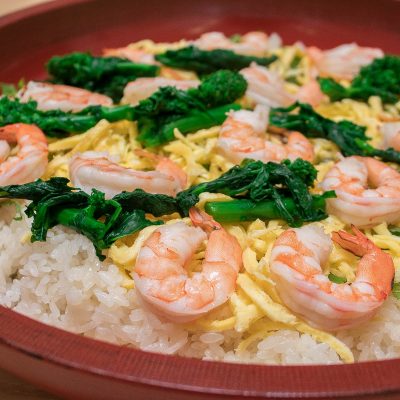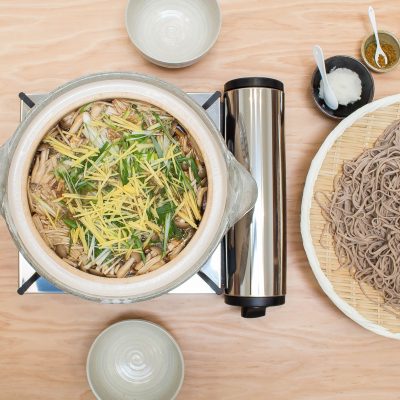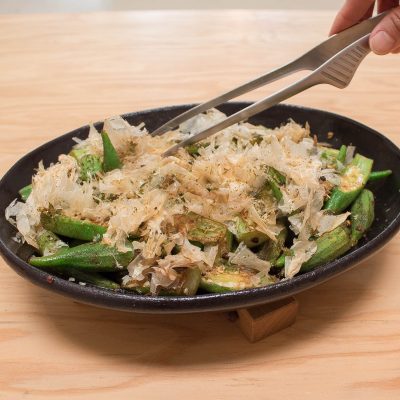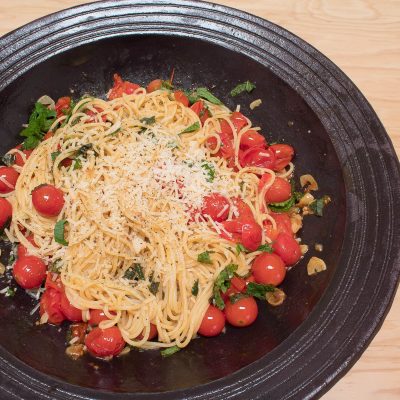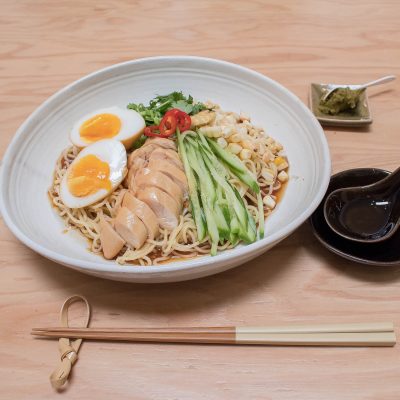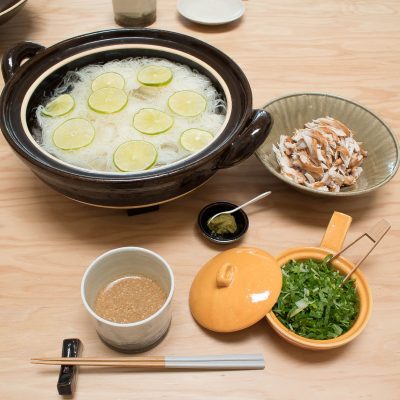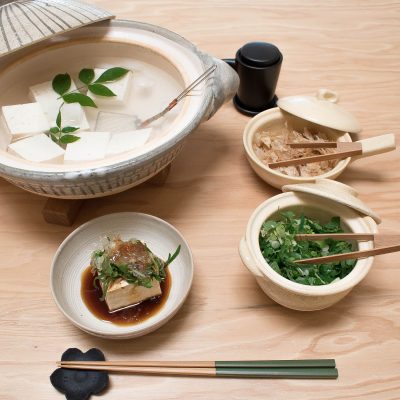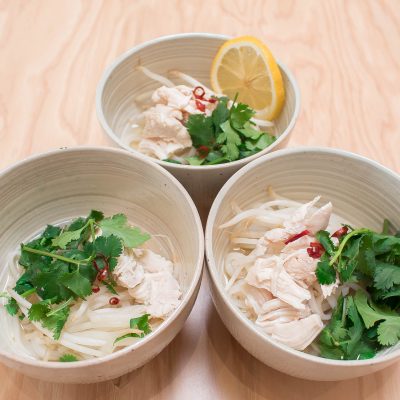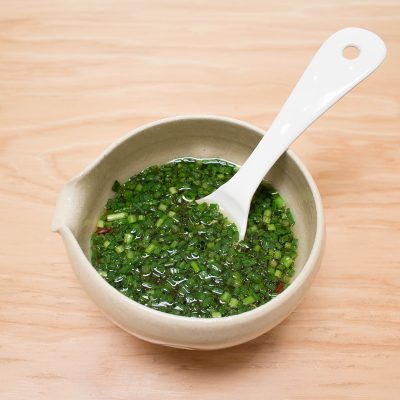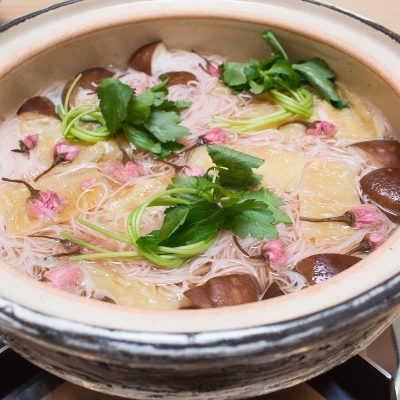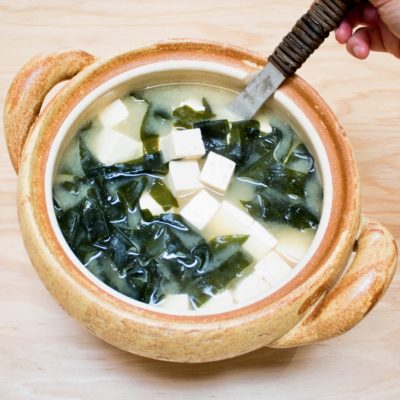Ginger Amazake Nabe – a healthy and delicious donabe hot pot recipe and it’s one of my favorite hot pot dishes of the season to bring comfort and keep me warm! Hope you get to try it home. Feel free to substitute chicken with just vegetables or seafood, to make it your own way.
Tag Archives: Vegan option
Tokoroten Noodles with Dashi Vinegar Sauce
Tokoroten is a very popular and traditional Japanese dish and it’s essentially simple kanten (agar jelly), cut into noodles. Tokoroten itself doesn’t really have flavors, so it’s served with sauce and toppings. It’s served chilled, so people enjoy tokoroten especially during the summer. It’s often served at Japanese traditional tea/ dessert parlors, and there are also vendors specialized in serving only tokoroten! In Tokyo, where I am from, and most of eastern Japan, tokoroten is enjoyed with vinegar-soy based sauce, so the vinegar can help alleviate the fatigue while the cold temperature of the dish helps cooling down your body. Tokoroten itself has very few calories, so it’s very light yet quite satisfying. I’ve been wondering why this dish has never caught up its popularity in the US yet…so, I thought I should introduce this beloved Japanese humble dish here. With my version, the sauce includes dashi, so it’s mild with extra layer of umami flavors.
To cut the kanten into tokoroten noodles, I use a traditional tokoroten-tsuki (a traditional tool designed specifically for cutting tokoroten noodles). It’s not only very easy to use, but it’s really fun to cut noodles with this.
In Kansai (including Kyoto and Osaka) and many parts of western Japan, tokoroten is typically enjoyed with sweet syrup and served as a dessert. So, my friends from Kyoto say they think tokoroten with vinegar-soy sauce is so strange.
How to Grill with Mizu Konro
Iga-yaki Water Grill, Mizu Konro is a portable grill set for tabletop charcoal grilling. It’s easy to set up, and once you have the ingredients ready, you can simply start grilling them on Mizu Konro at the table. The aroma of binchotan charcoal adds really wonderful flavors to the ingredients, and you can keep grilling and eating until you are full! The tabletop grill also makes a meal a fun event, as everybody can participate in the cooking and share the whole experience.
Make sure to enjoy using Mizu Konro outdoor or a very well-ventilated area if inside.
Black Cod Hot Pot in Saikyo Miso & Soymilk Broth
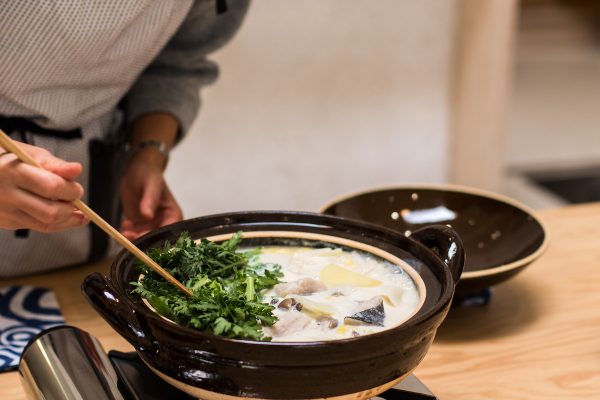
Saikyo miso is a traditional white miso from Kyoto, Japan. The color is pale and it has a natural umami-rich sweet flavor due to the higher content of koji rice (malted rice) in the miso. The sodium level is also much lower than other types of miso, so you can use a good amount of it to enjoy its rich flavor in a soup, etc. without making the dish too salty. This hot pot dish has the combination of dashi, soymilk, and Saikyo miso in the broth, so the flavor is rich and complex. Make sure to use the real Saikyo Miso from Kyoto and pure rich soymilk (with no additives) such as Banrai Soymilk.
Buttery fish like cod is perfect for this broth, other types of seafood or even chicken would certainly work in this dish, too.
Classic Chicken and Root Vegetable Stew
This is a traditional stew called Chikzen-ni, and is often served in a Japanese New Year meal, and one of my favorite New Year dishes since I was a child. The root vegetables such as burdock, lotus, carrot and sato-imo (taro) are cooked with konnyaku (yam jelly), dry shiitake, and chicken in dashi, and seasoned with soy sauce and black sugar. The flavor is so rich and you can really enjoy the nice earthy flavors.
When I serve this dish in the New Year, I cut the lotus and carrot into decorative shapes, but for any regular occasion, that’s not necessary.
Although I love the flavor of the chicken in Chikuzen-ni, this dish can easily be converted into a vegan dish by simply omit the chicken and use vegan dashi (i.e. kombu and dry shiitake dashi). You can also make it gluten-free by substituting the soy sauce and white tamari with tamari soy sauce.
Shrimp and Rapini Chirashi Sushi
Chirashi Sushi (sushi rice with scattered toppings) is a great dish for celebration, and I make this colorful dish for Japanese New Year or other party occasions. The most unique part about this dish is that the rice is seasoned with daidai citrus juice, instead of rice vinegar to make the sushi rice. Daidai is a Japanese citrus that is similar to orange but with brighter aroma and flavor. When the rice is seasoned with daidai juice, the beautiful aroma of daidai spreads around it and it’s so appetizing.
Egg crepes, rapini and shrimp create beautiful colorful visual and and the flavors are also wonderful together, too. Feel free to substitute them with other toppings of your choice for fun.
Soba Noodle with Green Onion and Shiitake Mushroom
Soba noodle is one of the most beloved traditional Japanese foods in Japan. Many people enjoy soba dishes for lunch, and there are soba restaurants (many are hand-made) and stands everywhere in Japan. At home, soba makes a very popular meal. This is my quick soba noodle dish I love and make all the time for lunch, and I change the toppings according to what I have in my fridge or pantry. Sometimes, I serve with just mushrooms, wakame seaweed, or even completely plain with a dash of yuzu citrus zest. With the porous body of the donabe, I like that the broth stays hot until the end of the meal.
Soba Noodle with Hot Mushroom Dipping Broth
I love making this dish especially when I am feeling a little weak and need something gentle for my stomach. Once you simmer mushrooms in a rich dashi-based broth, pour it into serving bowls and dip cold noodles in it to enjoy. The mushrooms adds the nice savory flavors to the broth. And, I love to use a generous amount of thinly-sliced ginger for both flavor and helping my body stay warm after having the dish. It’s so soothing and you can keep eating more and more. This dish is also nice to serve for a larger group. You can also change around the ingredients to cook in the broth for fun. For a vegan version, you can make with kombu dashi or vegetable dashi instead of kombu & bonito dashi.
Grilled Okra with Smoked Soy Sauce
This is a quick appetizer/side dish which requires little time for prepping. Toban cooks vegetables so effectively, allowing for them to become nicely charred. When the Smoked Soy Sauce is drizzled over the okra, it sizzles and brings an irresistible aroma. Finish with a generous mound of Shaved Katsuobushi, and sprinkle some Shichimi Togarashi. The katsuobushi will dance slowly on the okra and make a very appetizing presentation. I love making this dish with okra during the summer; asparagus is also great.
Shichimi-Flavored Cherry Tomato & Mint Pasta
When the cherry tomatoes are slowly heated with garlic and blistered in the oil in donabe, the flavor becomes even more bright and perfectly juicy. Once the tomatoes are blistered, all you need to do is just add the spaghetti, and toss with some mint. Finish with shaved Parmesan cheese and a generous amount of Shichimi Togarashi to enjoy. This simple dish is so rich and flavorful. I always have a hard time to stop heating it.
Smoked Chinese-style Cold Noodle
Smoked toppings give such a tasty and unique upgrade to the popular summer dish. This dish has not only been a summer hit at my home, but I actually like to make it whenever I want all year round. The yuzu-flavored broth is so refreshing and creates a nice balance with the smoked toppings. For me, Yuzu-Kosho is an essential addition to add a nice kick to this dish, but it’s totally optional for those who prefer a less spicy flavor.
Cold Somen Noodle with Golden Sesame Dipping Sauce
During the hot summer season in LA or Tokyo, ice-cold somen noodle is often the only thing I feel like having, and I never get tired of it. Did you know donabe is a perfect vessel for serving cold dish, too? With the porous clay body, donabe can keep the cold food very cold for a extended period of time. Also, it simply looks pretty to serve anything out of donabe, too! For this dish, I introduce my golden sesame dipping sauce. It’s rich in flavor yet refreshing. As for the toppings/ condiments, you can make it as simple like just sliced scallion and Shichimi Togarashi, or you can create a wide array of different toppings when you serve this dish to your guests. In this recipe, I serve with smoked chicken tender, mixed herbs and Yuzu-Kosho.
Chilled Tofu with Condiments
Hiyayakko is one of the most simple and beloved Japanese home dishes that is enjoyed all year round. It’s really about simple plain tofu, enjoyed with sliced scallion, shaved katsuobushi, and soy sauce or any condiments of your choice. In the summer time, to make the maximum “cold” effect by both taste and visual, I like to serve the tofu in ice bath in a donabe. Also in this way, you have a beautiful presentation and can even impress your guests. Medium-firm or soft tofu are recommended for hiyayakko, for the most pleasant texture.
Make Your Own Steamed Chicken Pho
Inspired by a popular Vietnamese noodle dish, this is my Japanese version of it and the dish totally takes advantage of the unique versatility of the donabe steamer, Mushi Nabe. I can do steaming and simmering in one pot, and it makes a great presentation at the table, too. I also love serving it hot pot style, so you can cook a small batch of noodles to serve at a time and continue to cook and serve until done. Then, you can choose and enjoy different toppings for every batch, if you like. You can be creative and serve with a wider variety of toppings, too. The broth has layers of umami flavors with the dashi, reserved chicken juice and Ayu fish sauce. This dish is always so comforting and fun at the same time. Instead of serving with a sliced lemon, you can also try with a splash of Pure Hon-Daidai Citrus Juice. The bright aroma of the daidai citrus will completely upgrade the dish to another level!
Daidai Chive Sauce
Very aromatic Daidai Citrus Juice and the umami-rich Ayu Fish Sauce create such a brightly refreshing flavor, and the generous amount of chives gives the nice herbal touch to the sauce. The golden sesame oil brings nutty character. This sauce takes no time to make, and it’s very versatile. So, enjoy with simple steamed fish, chicken, tofu, etc.
Somen Noodle and Cherry Blossoms Hot Pot
I always get so excited when the spring season comes and make a lot of cherry blossom-theme dishes. This is one of them and I add salt-preserved sakura (cherry blossom) flowers to the broth, and I even use the pink sakura-flavored somennoodles made from flour and sakura from Japan. The aroma of sakura in this dish is just so beautiful. But, don’t worry if you don’t have any of them! You can totally make the delicious somen hot pot without the sakura flavors, and this dish can be enjoyed all year round. You can also change the other ingredients to cook with the noodles by using different kinds of mushrooms or tofu, if you like. It’s so gentle on the stomach and always comforting.
Make Your Own Shoyu Ramen Hot Pot
Making ramen is easy and fun, especially if you cook and serve as donabe hot pot right at the table. I like adding the chopped nira (garlic chives) to the ramen right before serving, but if you can’t find nira, you can substitute with thinly-sliced green onion and serve as a topping, instead. Enjoy with a couple of simple toppings or a make a platter of a wide selection of toppings to choose from for fun.
Sansho Mayo
Just mix mayonnaise and some sansho powder, and all-purpose condiment is ready in a few seconds. Sansho adds the beautiful aromatic touch with tong-numbing spicy kick in the finish. Adjust the amount of sansho according to your taste. This condiment is great with smoked dish, fried chicken, fresh vegetable sticks, and so many more.
Tofu and Wakame Miso Soup
Tofu and wakame miso soup is such a classic Japanese soup, and it’s one of my ultimate comfort foods. Because Miso-shiru Nabe has such a high heat retention ability, the soup stays very hot for a long time after turning off the heat. Make sure to turn off the heat as soon as you add the miso, and never boil the soup, so you can really enjoy the most aromatic stage of the miso. If you have access, salt-preserved wakame (or sometimes it’s called “fresh wakame“) is recommended as it gives the nice fresh texture to the soup, and you can add it at the very end to the donabe or add to your bowl after the soup is poured into individual bowls.
Basic Smoking with Donabe Smoker, Ibushi Gin
Whether is simple sausages, fresh salmon, or boiled eggs, the Donabe Smoker, Ibushi Gin can make very aromatic smoked dishes in easy steps in a short time. Here’s the basic smoking guideline and tips for using Ibushi Gin large size, and the timing and measurements can be adjusted to your preference depending on what you smoke. The more you use it, the better you become in tweaking the process to best fit you.


